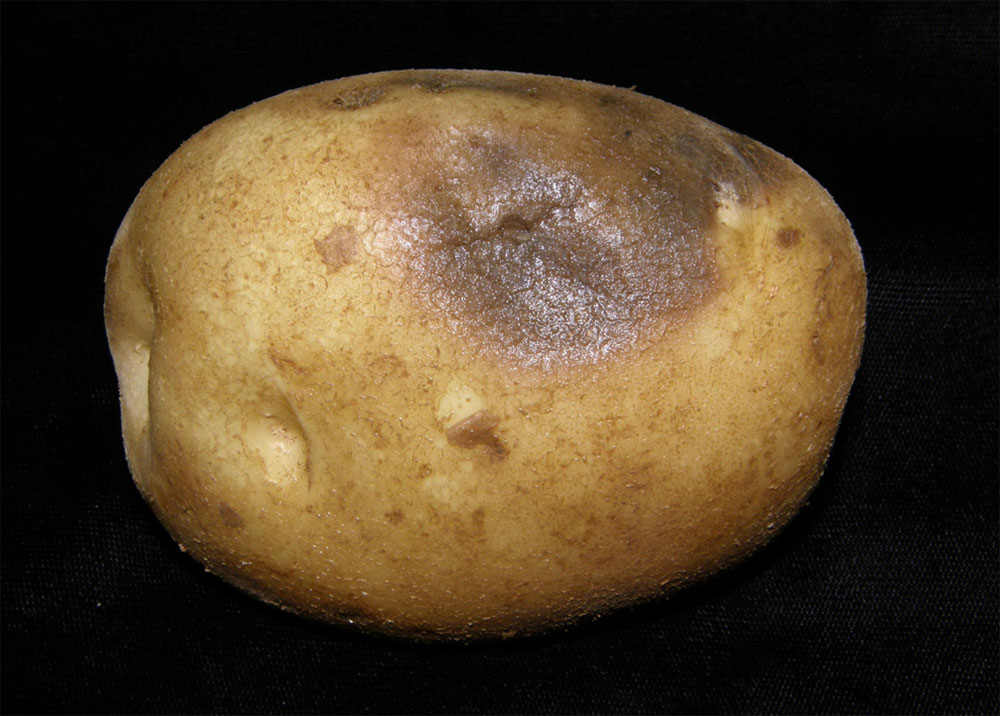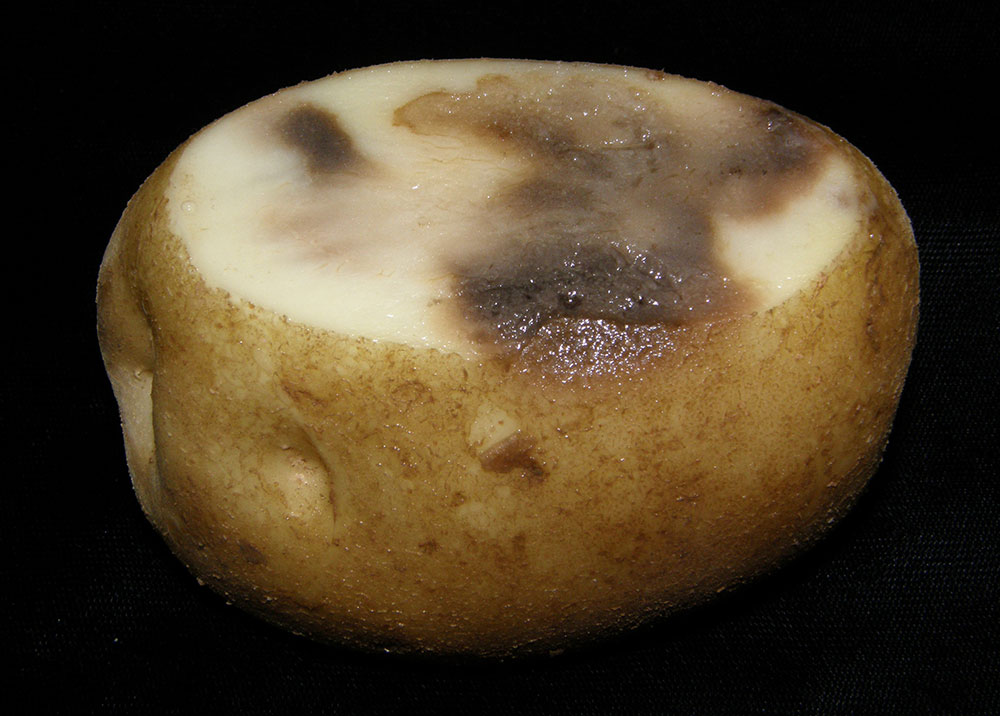Bulletin #2446, Potato Leak
Bulletin #2446, Potato Leak (PDF)
By Steven B. Johnson, Extension Crops Specialist, University of Maine Cooperative Extension
For information about UMaine Extension programs and resources, visit extension.umaine.edu.
Find more of our publications and books at extension.umaine.edu/publications/.
Potato leak is caused by several species of the soil-borne fungus-like organism, or oomycete, Pythium, with P. ultimum being the primary pathogen. This pathogen has a wide host range, attacking many crops and weeds. It is widely distributed in soils and water, and it survives on debris.
The disease is observed in storage shortly after harvest. Tuber wounds sustained during harvest and handling provide infection sites for the pathogen. Hot temperatures and wet soil conditions during harvest favor the pathogen. Affected tubers exhibit extremely wet breakdown in which clear fluid literally leaks out of the tuber, hence the name.
Recently, in parts of the US, potato leak has been found in the field before harvest where the pathogen has entered through the lenticels. This has not been seen in Maine.
Life cycle
Pythium produces sexual structures called oospores as a survival mechanism between host crops. These thick-walled spores can remain dormant, but viable, in the soil for many years. The disease begins when Pythium enters tubers through wounds, most typically during harvest, but wounds made during planting or post-harvest handling operations can also provide entry for the pathogen. The disease is halted below 50ºF, and the pathogen grows rapidly when temperatures are above 77ºF. When tuber pulp temperatures reach 65°F, potato leak symptoms can manifest. With pulp temperatures higher than 65°F, symptoms can become even more pronounced. Infected potato tubers can exhibit leak in as few as 36 hours under these high pulp temperatures. Pythium doesn’t transfer from tuber to tuber well in storage, but bacteria and other secondary rotting organisms can follow the pathogen and cause extensive losses.
Potato leak is most problematic in wet areas of a field, particularly when tuber pulp temperatures are high at harvest.
Symptoms
Potato leak has brown, water-soaked lesions around wounds on the tuber. The disease progresses quickly, with dark brown to light black watery rotted areas appearing inside the tuber. In the early stages, a distinct boundary between healthy and diseased tissue may be evident. Advanced symptoms include a hollowed-out shell. The slightest pressure on the tuber causes clear to slightly brownish liquid to leak out.



Potato leak can cause significant losses. In Maine, most potato-leak-related losses occur in storage, but losses in transport can occur if the potatoes are shipped soon after harvest.
Control
- Avoid harvesting when tuber pulp temperatures are 65°F or higher.
- Avoid mechanical damage when harvesting.
- Avoid harvesting in wet conditions.
- Harvest potatoes with well-set skin.
- Encourage rapid tuber wound healing.
Crop rotation, while always a good idea, will reduce, but not eliminate, the potato leak pathogen.
Reviewed by Associate Professor of Plant Pathology Jay Hao, University of Maine.
All photos by the author, Steven B. Johnson.
Information in this publication is provided purely for educational purposes. No responsibility is assumed for any problems associated with the use of products or services mentioned. No endorsement of products or companies is intended, nor is criticism of unnamed products or companies implied.
© 2018, 2020
Call 800.287.0274 (in Maine), or 207.581.3188, for information on publications and program offerings from University of Maine Cooperative Extension, or visit extension.umaine.edu.
In complying with the letter and spirit of applicable laws and pursuing its own goals of diversity, the University of Maine System does not discriminate on the grounds of race, color, religion, sex, sexual orientation, transgender status, gender, gender identity or expression, ethnicity, national origin, citizenship status, familial status, ancestry, age, disability physical or mental, genetic information, or veterans or military status in employment, education, and all other programs and activities. The University provides reasonable accommodations to qualified individuals with disabilities upon request. The following person has been designated to handle inquiries regarding non-discrimination policies: Director of Institutional Equity and Title IX Services, 5713 Chadbourne Hall, Room 412, University of Maine, Orono, ME 04469-5713, 207.581.1226, TTY 711 (Maine Relay System).

